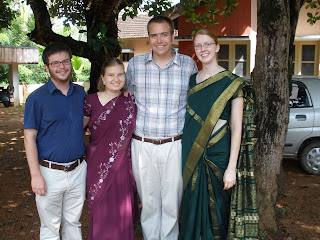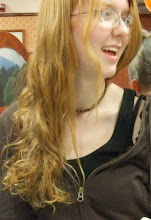
Photo of the four volunteers on our way to attend a wedding. Sarah and I had to wear saris for the first time in honor of the occasion. (Left to Right: Cameron, Sarah, Tyler, Me).
I wore a sari for my first Indian wedding last month, but that was a special occaison. After almost two months in Kerala, my life has begun to take on a regular routine. My work at the Nicholson Girls’ Higher Secondary School and in the nearby town of Tiruvalla has finally settled into a pattern that I can now share with you. Here is a breakdown of my average day:
• 7:00 – Wake up. All the girls at the school are already up by this time. They get up sometime between 4:30 and 6:30, depending on their age. In the morning some of the older girls study, and all the younger girls do exercise drills.
• 8:00 – Breakfast.
• 8:30 – Read the daily South Indian newspaper.
• 9:30-10:00 – Teach Christmas carols to one of the classes. In December the school will perform a carol service, and I’m in charge of teaching the girls English Christmas carols for them to sing at the program. These songs include traditional hymns like “Away in a Manger” and “It Came Upon a Midnight Clear” as well as some less common songs that are personal favorites of mine, such as “Do You Hear What I Hear?” and “God Rest Ye Merry Gentlemen.”
• 10:00-12:30 – Morning classes. I teach a few conversational English classes every morning. The purpose of these classes is to get the girls’ comfortable speaking in English because in Kerala everyone speaks to each other using their native language, which is Malayalam. I teach a wide variety of ages: preschool (where they are just learning the English alphabet) through eighth grade (where some are fluent in English).
• 1:00 – Lunch.
• 2:00-4:30 – Afternoon classes. Twice a week I teach afternoon classes at Nicholson. The rest of the week, I spend my afternoons in Tiruvalla doing other work. For example, I’m helping a local ecumenical organization that explores progressive perspectives on contemporary social issues in India. These issues can include concerns over identity politics, poverty, homosexuality, social discrimination based on caste, etc. It’s a great opportunity for me to get out of the close environment of the boarding school and engage more actively with relevant issues of social justice in Kerala.
• 4:30 – Afternoon tea. This is a necessary part of everyone’s day in Kerala. I have my afternoon tea and snack with the students. It’s a great time to sit and talk casually with them as we munch on sweet rolls, bananas, or vegetable-filled croissants.
• 5:00-6:00 – Free time/ Recess. I often spend this time playing games with the students. Basketball, badminton, duck-duck-goose, jump-rope, Uno, etc. The exception is on Mondays, when I teach a class at an evening school hosted by a local church. This evening school is particularly for children from poorer families who can’t go to regular school or who need extra help with their homework.
• 6:30-7:30 – Malayalam lesson. I have a fabulous Malayalam teacher at Nicholson who tutors me every night, as I struggle to learn the local language.
• 8:00 – Dinner.
• 8:30-11:00 – Me time. In the evening I get time to myself when I can read, write in my journal, build the next days lesson plans, etc.
Daily Joys and Challenges
My days here are filled with major and minor joys and challenges. Everyday something fills me with delight, but everyday I also face problems and challenges with which I seriously struggle.
One of the greatest challenges for me is the language barrier. English is one of the official languages of India, but in Kerala, no one really speaks in English. I learned when I arrived here that India is broken into fourteen different states. The divisions of these states are based on language. So, each of the fourteen states has its own language (and its own unique culture too), which everyone speaks there but which isn’t spoken in any other state in India. That’s why everyone has to learn English and Hindi in school. In Kerala, the language is Malayalam, and although every student learns English in school and college lectures and admission exams are in English, all daily conversation in Kerala is conducted in Malayalam. And, of course, since people don’t regularly speak in English, many of the students and teachers aren’t completely comfortable speaking English. So I have to work through this language barrier everyday in the classes I teach and in my relationships with the students and teachers at the school.
So, of course, I’m very motivated to learn Malayalam because I want to understand people when they speak and I want to strengthen my relationships with improved communication. I study with a tutor every night, and slowly, I am learning. But Malayalam is supposedly the second most difficult language in the world, after Mandarin Chinese. There are 56 letters in the Malayalam alphabet, but since all the vowels have a separate symbol that is used in the middle of words and some letters contract to form new letters, I think there are closer to 100 letters in Malayalam. And some of the letters represent sounds that I can’t pronounce correctly no matter how I try. Hopefully, this gives you some idea of how much of a struggle Malayalam is for me. But as I said, I am learning. I know the alphabet. I can count to 100 and say the colors. I know 20-some verbs, and I can say that “I have one older brother; his name is Benjamin.” But it’s very difficult. And I can’t express complicated ideas in Malayalam, and sometimes, even in English, abstract concepts are lost in translation. So at the school, it’s often difficult to talk about my opinions on climate change, or the unequal distribution of wealth in India, or gender and racial discrimination. I should point out that this is not always the case. I’ve had some wonderful conversations with people both at Nicholson and outside of the school, but the language barrier is always present in some way, shape, or form, and deep, meaningful communication is sometimes a challenge.
But despite the challenges, my life here is also full of joy. Every day holds something that delights me. Often these joys come from simple, small things, like a successful Malayalam conversation with one of the kitchen workers or eating my favorite Kerala food for breakfast. Here are some of the other daily joys that fill by new life here in Kerala:
• The smiles of the students when they tell me about their family or their favorite foods.
• The way some of the teachers will take my hand or touch my arm when they say hello as a sign of my inclusion in the sorority that exists among women here.
• Being greeted by people on the street who recognize me from one place or another.
• The many different kinds of bananas that I am always sampling. I’ve had at least seven or eight different kinds since coming to Kerala, and they’re wonderful. Most are miniature bananas and are sweeter and smoother than the one kind of banana we have in the States.
• The way the fifth grade girls, in whose dormitory my room is located, will sometimes knock on my door in the evening, just to say goodnight.
• The lingering smell of sandalwood soap after I bathe.
• The openness of the girls who bring me the stories and poems that they write in English so that I can help them with their creative writing.
• The sweet-sour taste of passion fruit.
• The practice of 4pm tea and the opportunity it provides for relaxation.
• The peace of sitting quietly in my room in the evening as I reflect on the past day.
• The joy of recognizing, of truly seeing, all the beauty that surrounds me here.

